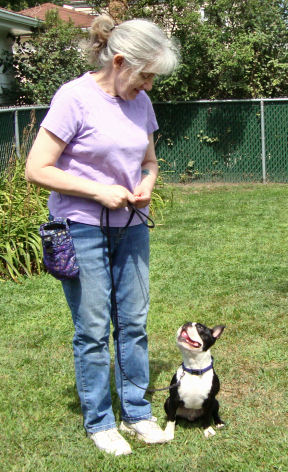There are always going to be real-world distractions in dog training. It’s how you cope with them that matters.
You never know when “SQUIRREL!” will cross your path. But you can prepare your dog to deal with distractions.
Fran and Simon, her 3-year-old Boston Terrier, competed in his second agility trial recently. It was a familiar environment – the same place they have weekly classes. The obstacles and jumps were ones he knows. And yet – he was completely distracted. Why? There were people in the ring with him!
In agility, volunteers are dispersed around the field to pick up dropped bars, reset jump heights, etc. to keep agility trials moving efficiently. But Simon had never seen people sitting on chairs in the ring before. So he felt compelled to go and say “Hi!” to all of them.
Distraction dog training
Dogs, like Simon, are going to notice things. That’s their nature. You can’t stop your dog from seeing and hearing the world around them. What you can do is show them how to stay focused despite distractions.

How is Simon going to learn to pay attention to Fran (and what he’s supposed to be doing) instead of visiting? This week in class, she’s going to ask her classmates to pretend to be those trial volunteers. And she’s going to be more fun than people sitting quietly in chairs. When Simon goes to say “Hi!,” those classmates are going to sit still and look anywhere but at Simon. Fran’s going to run away from Simon (triggering his chase instinct and his inherent curiosity), calling him. And when he comes dashing after her, she’s going to reward him mightily. And then they’ll continue running their agility practice.
The real-world application is the same.
How to train for distractions
The key is right there. Be more interesting than the distraction. Our students are often hesitant about being noisy, or playing with toys, or over-rewarding their dogs in class. People are taught to not be “disruptive” or make a fuss in public.
Get over it. Your dog isn’t going to pay attention if you’re boring. And, realistically, no one’s paying attention to you, anyway. They’re watching your dog. What they see in your dog is up to you. They can admire the cute, well-trained dog with you. Or they can “tsk” and shake their heads over the poorly-behaving hooligan.
Time & patience
It’s really difficult for people to embrace the idea of rewarding your dog every single time he looks at you. It’s hard to watch your dog’s face and look where you’re going. That’s why you practice in familiar surroundings and straight lines, so you don’t trip and hurt yourself. But that focus on you – rewarding your dog EVERY SINGLE TIME they look at you, is the foundation for all good training. Focus is key. (Check out the Looky Loo game for more distraction work.)
It doesn’t mean your dog stares adoringly into your eyes all the time, for every step. It means that they check in with you on a regular basis. Because they know it will be rewarded. What gets rewarded, gets repeated.
Calling it something
When you’re building the “check in” habit, you can call it “watch,” “here,” “check,” or whatever works for you. But it shouldn’t just be the dog’s name. Dogs hear their names constantly, with little or no information attached to it. So, more often than not, they ignore it. We have one student who says her dog’s name all the time, despite us hounding her not to. And when he hears it, he tends to look away, rather than at her. Because she’s reluctant to reward. When he does look at her, he gets an occasional “good boy!” even with us yelling “Reward that!” “Cookie him!”
Building the “check in” behavior pays dividends in the real world. If you’re out walking and see “SQUIRREL!” use your check-in and have rewards ready. The better the reward, the more likely your dog will find you more interesting than the distraction. In your dog’s opinion, you should be more interesting than anything else in the world. It’s not hard to do – they already adore you!
